Czechoslovakia
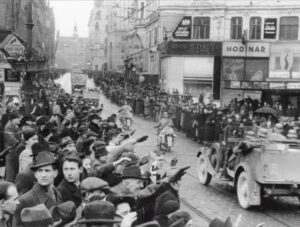 Normally, when you think of something like International Students’ Day, most of us think of a day of things like walkouts, protests, and other days during which students are expected to conform to a collective norm of all these issues, like climate change, anti-war protests, and such. No matter what your stance on that is, this is not why International Students’ Day is commemorated. On November 17, 1939, in Czechoslovakia, students the University of Prague were demonstrating against the German occupation of Czechoslovakia. The Nazi occupation was protested by many groups, and yet, what was a legal protest, was turned into a mass invasion and murder of the student protesters. The event was similar to the Tiananmen Square massacre in which they opened fire on the protesters in China. That one was the Chinese government, while this one was the Nazis. I’s sure the Tiananmen Square massacre was illegal in China, but that was not the case…supposedly anyway, with the Czech protests. Today, the nations have come together in remembering the nine students who were killed, and the others who were sent to concentration camps as a result of their participation in protests over German occupation.
Normally, when you think of something like International Students’ Day, most of us think of a day of things like walkouts, protests, and other days during which students are expected to conform to a collective norm of all these issues, like climate change, anti-war protests, and such. No matter what your stance on that is, this is not why International Students’ Day is commemorated. On November 17, 1939, in Czechoslovakia, students the University of Prague were demonstrating against the German occupation of Czechoslovakia. The Nazi occupation was protested by many groups, and yet, what was a legal protest, was turned into a mass invasion and murder of the student protesters. The event was similar to the Tiananmen Square massacre in which they opened fire on the protesters in China. That one was the Chinese government, while this one was the Nazis. I’s sure the Tiananmen Square massacre was illegal in China, but that was not the case…supposedly anyway, with the Czech protests. Today, the nations have come together in remembering the nine students who were killed, and the others who were sent to concentration camps as a result of their participation in protests over German occupation.
The world was so shocked by the killings and the taking of captives, but not much could be done. Among the dead were Jan Opletal and worker Václav Sedlácek. The Nazis rounded up the students, murdered nine student leaders and sent over 1,200 students to concentration camps, mainly to Sachsenhausen. As a result of the attacks, all Czech universities and colleges were closed. Technically, by this time Czechoslovakia no longer  existed, as it had been divided into the Protectorate of Bohemia and Moravia and the Slovak Republic under a fascist puppet government. The Nazi authorities were in the Protectorate of Bohemia and Moravia. Their main target was students of the Medical Faculty of Charles University. That demonstration was held on October 28, and it was to commemorate the anniversary of the independence of the Czechoslovak Republic in 1918. During this demonstration the student Jan Opletal was shot, and later died from his injuries on November 11th. On November 15th, his body was supposed to be transported from Prague to his home in Moravia. The funeral procession attracted thousands of students, who turned the event into an anti-Nazi demonstration. The Nazis would not allow such a demonstration, so the Nazi authorities took drastic measures in response. They closed all Czech higher education institutions, and arrested the more than 1,200 students, all of whom were then sent to concentration camps. They also executed nine students and professors without trial on November 17th. Historians speculate that the Nazis granted permission for the funeral procession already expecting a violent outcome. Their plan was to use that as a pretext for closing down universities and purging anti-fascist dissidents. I would have to agree. In that way, it was easier to place blame on the students and staff, and not the Nazis.
existed, as it had been divided into the Protectorate of Bohemia and Moravia and the Slovak Republic under a fascist puppet government. The Nazi authorities were in the Protectorate of Bohemia and Moravia. Their main target was students of the Medical Faculty of Charles University. That demonstration was held on October 28, and it was to commemorate the anniversary of the independence of the Czechoslovak Republic in 1918. During this demonstration the student Jan Opletal was shot, and later died from his injuries on November 11th. On November 15th, his body was supposed to be transported from Prague to his home in Moravia. The funeral procession attracted thousands of students, who turned the event into an anti-Nazi demonstration. The Nazis would not allow such a demonstration, so the Nazi authorities took drastic measures in response. They closed all Czech higher education institutions, and arrested the more than 1,200 students, all of whom were then sent to concentration camps. They also executed nine students and professors without trial on November 17th. Historians speculate that the Nazis granted permission for the funeral procession already expecting a violent outcome. Their plan was to use that as a pretext for closing down universities and purging anti-fascist dissidents. I would have to agree. In that way, it was easier to place blame on the students and staff, and not the Nazis.
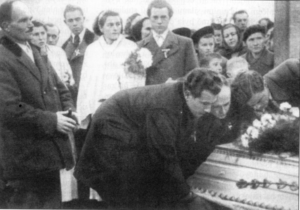 In 2009, on the 70th anniversary of November 17, 1939, OBESSU and ESU promoted a number of initiatives throughout Europe to commemorate the date. An event was held from the 16th to the 18th of November at the University of Brussels, focusing on the history of the students’ movement and its role in promoting active citizenship against authoritarian regimes. The conference gathered around 100 students representing national students and student unions from over 29 European countries, as well as some international delegations. Today, International Students’ Day is a day of remembrance to honor these brave students, who gave their lives and their freedom for a cause the believed in. Some countries, like Czechoslovakia have named it a national holiday.
In 2009, on the 70th anniversary of November 17, 1939, OBESSU and ESU promoted a number of initiatives throughout Europe to commemorate the date. An event was held from the 16th to the 18th of November at the University of Brussels, focusing on the history of the students’ movement and its role in promoting active citizenship against authoritarian regimes. The conference gathered around 100 students representing national students and student unions from over 29 European countries, as well as some international delegations. Today, International Students’ Day is a day of remembrance to honor these brave students, who gave their lives and their freedom for a cause the believed in. Some countries, like Czechoslovakia have named it a national holiday.
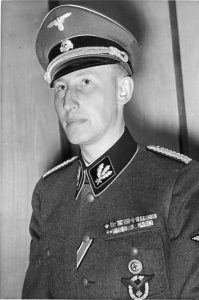 During the evil reign of the Nazi regime, we saw leaders of occupied nations being replaced by a Nazi official, who was in agreement with Hitler on the way things should be run. The deposed leader was then exiled, or worse yet, murdered. In September 1941, Reinhard Heydrich, a high-ranking Nazi official and a primary architect of the holocaust, was named Reich Protector of Bohemia and Moravia (formerly Czechoslovakia). He wasted no time in declaring martial law, and then began executing political prisoners and intelligentsia, and deported the sizable Czech Jewish community. During this time, the Czech government had been exiled to London, but they could not stand what was happening to their countrymen, so they decided to assassinate Heydrich…and so, Operation Anthropoid was born.
During the evil reign of the Nazi regime, we saw leaders of occupied nations being replaced by a Nazi official, who was in agreement with Hitler on the way things should be run. The deposed leader was then exiled, or worse yet, murdered. In September 1941, Reinhard Heydrich, a high-ranking Nazi official and a primary architect of the holocaust, was named Reich Protector of Bohemia and Moravia (formerly Czechoslovakia). He wasted no time in declaring martial law, and then began executing political prisoners and intelligentsia, and deported the sizable Czech Jewish community. During this time, the Czech government had been exiled to London, but they could not stand what was happening to their countrymen, so they decided to assassinate Heydrich…and so, Operation Anthropoid was born.
Two Czech agents, Jan Kubis and Josef Gabcik, had undergone extensive training by British intelligence, and on December 29, 1941, were successfully parachuted into Czechoslovakia. Once on the ground, they had to establish themselves, so they spent six months perfecting a plan with local resistance fighters, who were more 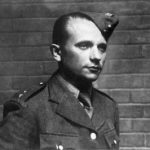
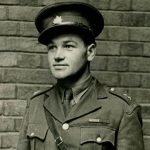 than happy to lend a hand in such an important mission. The plan was perfect. The Reich Protector didn’t think he had anything to fear from the local citizens, whom he assumed were beaten down and obedient. On May 27, 1942, Kubis and Gabcik secretly waited along Heydrich’s usual morning route to the Nazi’s Prague headquarters. Reich Protector Heydrich was an arrogant man, and he boldly rode in an open Mercedes convertible, thinking himself invincible, or at the very least well protected.
than happy to lend a hand in such an important mission. The plan was perfect. The Reich Protector didn’t think he had anything to fear from the local citizens, whom he assumed were beaten down and obedient. On May 27, 1942, Kubis and Gabcik secretly waited along Heydrich’s usual morning route to the Nazi’s Prague headquarters. Reich Protector Heydrich was an arrogant man, and he boldly rode in an open Mercedes convertible, thinking himself invincible, or at the very least well protected.
In an unfortunate turn of events, the machine gun Gabcik pointed at Heydrich, as his vehicle slowed at an L-shaped curve, misfired. Heydrich ordered his driver to stop, planning to shoot Gabcik, but Kubis tossed a 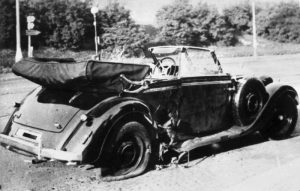 grenade and the Reich Protector’s car, which detonated near the car’s right fender. Both Kubis and Gabcik escaped and Heydrich, who initially thought he was uninjured, died on June 4, 1942. So, in the end the assassination was successful, if not strangely carried out. Unfortunately, not all resistance members are loyal, some can be bought off, and that is what happened in this case. Kubis and Gabcik were betrayed by a resistance member and died heroically, on June 18, 1942, after a gunfight with the Gestapo at a Prague church. While these men ultimately gave their lives for this cause, they were heroes, because the target, Reich Protector Heydrich was assassinated, and that was vital.
grenade and the Reich Protector’s car, which detonated near the car’s right fender. Both Kubis and Gabcik escaped and Heydrich, who initially thought he was uninjured, died on June 4, 1942. So, in the end the assassination was successful, if not strangely carried out. Unfortunately, not all resistance members are loyal, some can be bought off, and that is what happened in this case. Kubis and Gabcik were betrayed by a resistance member and died heroically, on June 18, 1942, after a gunfight with the Gestapo at a Prague church. While these men ultimately gave their lives for this cause, they were heroes, because the target, Reich Protector Heydrich was assassinated, and that was vital.
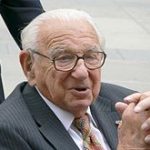 His name was Sir Nicholas George Winton MBE, but in his early years, he had not been bestowed with such an honor as knighthood. That came about much later in his life. Sir Winton was born on May 19, 1909 in Hampstead, London, England. He was a British humanitarian, born to German-Jewish parents, Rudolph Wertheim (1881–1937), a bank manager, and his wife Barbara (née Wertheimer, 1888–1978) who had emigrated to Britain. His parents had moved to London two years before he was born. The family name was Wertheim, but they changed it to Winton in an effort at integration. They also converted to Christianity, and Winton was baptized. God had a plan for Sir Winton’s life, although he would not know that for years.
His name was Sir Nicholas George Winton MBE, but in his early years, he had not been bestowed with such an honor as knighthood. That came about much later in his life. Sir Winton was born on May 19, 1909 in Hampstead, London, England. He was a British humanitarian, born to German-Jewish parents, Rudolph Wertheim (1881–1937), a bank manager, and his wife Barbara (née Wertheimer, 1888–1978) who had emigrated to Britain. His parents had moved to London two years before he was born. The family name was Wertheim, but they changed it to Winton in an effort at integration. They also converted to Christianity, and Winton was baptized. God had a plan for Sir Winton’s life, although he would not know that for years.
On the eve of World War II, Sir Winton knew what his calling had been, and he quietly set about orchestrating the rescue of 669 children, most of them Jewish, from Czechoslovakia. Sir Winton quickly found homes for the children and arranged for their safe passage to Britain. The operation was known as the Czech Kindertransport, which is German for “children’s transport, but it would not be called that right away. The transport was not a official operation, and was not sanctioned as such. He worked largely alone to set this up, and most people knew nothing about it for over 50 years, but the children did not forget the man they called the British Schindler, who had saved their lives.
Then, in 1988, he was invited to the BBC television program “That’s Life!.” It was a surprise party of sorts. Little 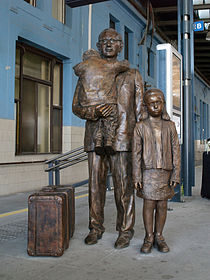 did Sir Winton know, but his secret was no longer such a secret. Arriving at the show, Sir Winton was seated in a room full of people he did not know. Soon, the truth was told to him, and he found out that the “audience” was in fact a number of the children he had rescued all those years ago. The grateful children, now grown adults, wanted to reunite with the man who had saved then all those years ago. It was the British press who celebrated him and dubbed him the “British Schindler.” Sir Winton was brought to tears, as he looked around him at all of these people who owed him their very lives, but his story did not end there. In 2003, Nicholas Winton became Sir Nicholas George Winton MBE (Most Excellent Order of the British Empire), when he was knighted by Queen Elizabeth II for “services to humanity, in saving Jewish children from Nazi Germany occupied Czechoslovakia.” Then, on October 28, 2014, he was awarded the highest honor of the Czech Republic, the Order of the White Lion (1st class), by Czech President Miloš Zeman. The little German-Jewish boy, whose family converted to Christianity, and who always felt a love for humanity and those in need, had become a great man indeed. God did have a plan for his life, and Sir Winton had made God proud. Sir Nicholas George Winton MBE passed away peacefully in his sleep on July 1, 2015, at Wexham Park Hospital, Slough, Berkshire, England, at the age of 106 years, having lived a full life. After the war, Winton worked for the International Refugee Organization and then the International Bank for Reconstruction and Development in Paris, where he met Grete Gjelstrup, a Danish secretary and accountant’s daughter. They married in her hometown of Vejle on October 31, 1948. The couple settled in Maidenhead, England, where they raised their three children: Nick (born 1951), Barbara (born 1954) and the youngest Robin (1956–1962), who was born
did Sir Winton know, but his secret was no longer such a secret. Arriving at the show, Sir Winton was seated in a room full of people he did not know. Soon, the truth was told to him, and he found out that the “audience” was in fact a number of the children he had rescued all those years ago. The grateful children, now grown adults, wanted to reunite with the man who had saved then all those years ago. It was the British press who celebrated him and dubbed him the “British Schindler.” Sir Winton was brought to tears, as he looked around him at all of these people who owed him their very lives, but his story did not end there. In 2003, Nicholas Winton became Sir Nicholas George Winton MBE (Most Excellent Order of the British Empire), when he was knighted by Queen Elizabeth II for “services to humanity, in saving Jewish children from Nazi Germany occupied Czechoslovakia.” Then, on October 28, 2014, he was awarded the highest honor of the Czech Republic, the Order of the White Lion (1st class), by Czech President Miloš Zeman. The little German-Jewish boy, whose family converted to Christianity, and who always felt a love for humanity and those in need, had become a great man indeed. God did have a plan for his life, and Sir Winton had made God proud. Sir Nicholas George Winton MBE passed away peacefully in his sleep on July 1, 2015, at Wexham Park Hospital, Slough, Berkshire, England, at the age of 106 years, having lived a full life. After the war, Winton worked for the International Refugee Organization and then the International Bank for Reconstruction and Development in Paris, where he met Grete Gjelstrup, a Danish secretary and accountant’s daughter. They married in her hometown of Vejle on October 31, 1948. The couple settled in Maidenhead, England, where they raised their three children: Nick (born 1951), Barbara (born 1954) and the youngest Robin (1956–1962), who was born 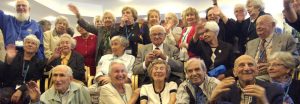 with Down syndrome. At the family’s insisted Robin stayed with them, rather than being sent to a residential home. Sir Winton’s son, Robin died of meningitis, the day before his sixth birthday. The death was devastating for Winton and he founded a local support organization that later became Maidenhead Mencap. Winton stood, unsuccessfully, for the town council in 1954, but later found work in the finance departments of various companies. His wife, Grete preceded him in death in 1999. Sir Nicholas George Winton MBE was a truly remarkable man.
with Down syndrome. At the family’s insisted Robin stayed with them, rather than being sent to a residential home. Sir Winton’s son, Robin died of meningitis, the day before his sixth birthday. The death was devastating for Winton and he founded a local support organization that later became Maidenhead Mencap. Winton stood, unsuccessfully, for the town council in 1954, but later found work in the finance departments of various companies. His wife, Grete preceded him in death in 1999. Sir Nicholas George Winton MBE was a truly remarkable man.
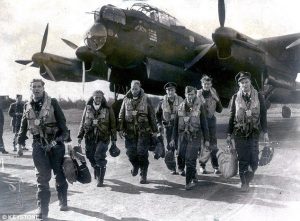 In April of 1943, during a raid on a Czechoslovakian arms factory, a British bomber crashed in Germany, going down with seven crew members on board. At the time of the crash, German soldiers recovered two of the bodies, but somehow they didn’t find or recover the bodies of the other five crewmen. It seems odd to me that they couldn’t find them, or that they somehow just chose not to bury the remaining five crewmen. Because the extensive search, following the war, produced nothing, the British Air Ministry assumed that the plane had ditched in the sea.
In April of 1943, during a raid on a Czechoslovakian arms factory, a British bomber crashed in Germany, going down with seven crew members on board. At the time of the crash, German soldiers recovered two of the bodies, but somehow they didn’t find or recover the bodies of the other five crewmen. It seems odd to me that they couldn’t find them, or that they somehow just chose not to bury the remaining five crewmen. Because the extensive search, following the war, produced nothing, the British Air Ministry assumed that the plane had ditched in the sea.
The plane, an Avro Lancaster, piloted by Alec Bone, took off from Lincolnshire, England, almost 76 years ago. Their target was a munitions plant in German-occupied Czechoslovakia. A total of 327 bombers took off that day, and 36 would never return. Bone’s plane was one of those unfortunate 36 planes. It is believed that he and his crew battled German antiaircraft fire before plunging into a field outside Laumersheim in southwestern Germany. As it searched in vain for the missing crew in the years following World War II, the British Air Ministry had no idea that German troops had already buried two of the men in Mannheim.
There was, however, one person who knew the location of the plane…Peter Menges, who was a teenager at the time he witnessed the fiery crash of the British bomber. It was a site he would ever forget, but I’m sure he assumed that the Germans had found it too, and gone to remove the bodies or any survivors. This whole  situation made me wonder why the other five men were not buried too. Upon researching this crash, I think I have discovered why. Most of us picture a plane crash with a broken plane and the bodies of the dead lying almost peacefully nearby, but most often it isn’t like that at all. When airplanes crash, they hit the ground going very fast, and the human body doesn’t handle that kind of impact very well. In fact it reacts much like an explosion, with pieces scattered all over the place. And when a plane nose dives into the ground, burying itself deep in the ground, like this one did, those body parts are often buried too.
situation made me wonder why the other five men were not buried too. Upon researching this crash, I think I have discovered why. Most of us picture a plane crash with a broken plane and the bodies of the dead lying almost peacefully nearby, but most often it isn’t like that at all. When airplanes crash, they hit the ground going very fast, and the human body doesn’t handle that kind of impact very well. In fact it reacts much like an explosion, with pieces scattered all over the place. And when a plane nose dives into the ground, burying itself deep in the ground, like this one did, those body parts are often buried too.
Menges who was 83 in 2012, when he told the tale of the fiery crash of Alec Bone’s plane. He had joined forces with Uwe Benkel, a health insurance clerk, who moonlighted as a military history researcher. Together they have helped to recover more than 100 planes. Upon learning of the exact location of the crash, a team of men used metal detectors and ground-penetrating radar to confirm the crash location near Laumersheim. Their search first unearthed the bomber’s engine and landing gear, along with hundreds of bone fragments thought to be the remains of the missing men. My guess is that because of the planes burial at the site, and the fact that most of the bodies were blown to bits at the time of the impact, the German soldiers who were at the scene to bury the bodies that day, simply could not find the other bodies.
Because no one knew where to look, the families never knew what happened for sure. They could only speculate. Now, the remains of the five British airmen have been found. Their relatives have been notified and 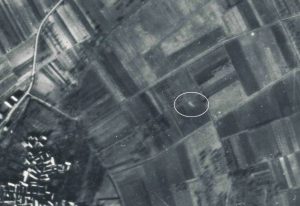 plans are being made to bury the men in a shared coffin at Germany’s Commonwealth War Graves Cemetery. Benkel told British news sources that area residents wondered why he was searching for former enemies who had bombed German cities. “It doesn’t make a difference if they are German or British,” he told The Telegraph. “They were young men who fought and died for their country for which they deserve a proper burial in a cemetery.” I agree. No matter which side of a battle a soldier fought on, he fought to the best of his or her abilities, and that deserves respect, and a proper burial. “They flew together and died together,” says Mr Benkel. “It is only right that they should stay together.”
plans are being made to bury the men in a shared coffin at Germany’s Commonwealth War Graves Cemetery. Benkel told British news sources that area residents wondered why he was searching for former enemies who had bombed German cities. “It doesn’t make a difference if they are German or British,” he told The Telegraph. “They were young men who fought and died for their country for which they deserve a proper burial in a cemetery.” I agree. No matter which side of a battle a soldier fought on, he fought to the best of his or her abilities, and that deserves respect, and a proper burial. “They flew together and died together,” says Mr Benkel. “It is only right that they should stay together.”
 As the world is watching the 2018 Winter Olympics, officially known as the XXIII Olympic Winter Games and commonly known as PyeongChang 2018, looking at the hope for gold in this group of young talented athletes, I have been thinking back to another group of young talented athletes…athletes that would never get the chance to realize their dreams. Yes, this group had won gold before, so they were not new to the world of competition, but their hopes of any future gold were crushed forever on February 15, 1961, when they were on their way to the 1961 World Figure Skating Championships in Prague, Czechoslovakia.
As the world is watching the 2018 Winter Olympics, officially known as the XXIII Olympic Winter Games and commonly known as PyeongChang 2018, looking at the hope for gold in this group of young talented athletes, I have been thinking back to another group of young talented athletes…athletes that would never get the chance to realize their dreams. Yes, this group had won gold before, so they were not new to the world of competition, but their hopes of any future gold were crushed forever on February 15, 1961, when they were on their way to the 1961 World Figure Skating Championships in Prague, Czechoslovakia.
On that day, the entire 18 member United States figure skating team, along with the 16 people who were accompanying them, which included family, friends, coaches and officials, as well as the crew and 38 people who were not with the figure skating team, died when the plane went down around 10am in clear weather while attempting to make a scheduled stopover landing at the Belgian National Airport in Brussels. One person on the ground, a farmer working in the field where the Boeing 707 crashed in Berg-Kampenhout, several miles from the airport, was killed by some shrapnel. Investigators were unable to 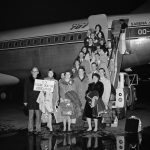 determine the cause of the crash, although mechanical difficulties were suspected.
determine the cause of the crash, although mechanical difficulties were suspected.
Killed in the crash was 16 year old Laurence Owen, who had won the U.S. Figure Skating Championship in the ladies’ division the previous month. She was featured on the February 13, 1961, cover of Sports Illustrated, which called her the “most exciting U.S. skater.” Bradley Long, the 1961 U.S. men’s champion, also perished in the crash, as did Maribel Owen (Laurence’s sister) and Dudley Richards, the 1961 U.S. pairs champions, and Diane Sherbloom and Larry Pierce, the 1961 U.S. ice dancing champions. Also killed was 49-year-old Maribel Vinson-Owen, a nine-time U.S. ladies’ champion and 1932 Olympic bronze medalist, who coached scores of skaters, including her daughters Maribel and Laurence, and Frank Carroll, who went on to coach the 2010 men’s Olympic gold medalist Evan Lysacek and nine-time U.S. champion Michelle Kwan. The crash was a tragedy that devastated the U.S. figure skating program and meant the loss of the country’s top skating talent. Prior to the crash, the U.S. had won the men’s gold medal at every Olympics since 1948…when Dick Button became the first American man to do so, while U.S. women had claimed Olympic gold in 1956 and 1960. After the crash, an American woman named Peggy Fleming would be the next to win, but she would not capture Olympic gold until 1968, while a U.S. man, Scott Hamilton would not do so until 1984. The incident was the 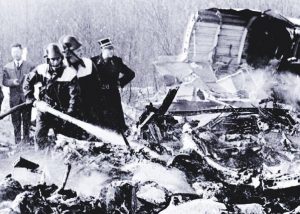 worst air disaster involving a U.S. sports team until November 1970, when 37 players on the Marshall University football team were killed in a plane crash in West Virginia.
worst air disaster involving a U.S. sports team until November 1970, when 37 players on the Marshall University football team were killed in a plane crash in West Virginia.
Shortly after the 1961 crash, the U.S. Figure Skating Memorial Fund was established. To date, it has provided financial assistance to thousands of elite American skaters. In 2011, the 50th anniversary of the tragedy, the 18 members of the 1961 figure skating team, along with the 16 people traveling with them to Prague, were inducted into the U.S. Figure Skating Hall of Fame in Colorado Springs, Colorado.
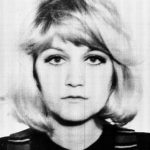 For most of us, taking a fall, of any kind is no fun. Taking a fall off of a one story roof is terrifying, and if we were to fall from a two story building, we might not expect to live through it. For Serbian flight attendant, Vesna Vulovic a two story fall is like stubbing her toe. On January 26, 1972, while she was working on JAT Flight 367, a terrorist bomb exploded on the plane. Vesna found herself in a freefall without a parachute at an altitude of 33,333 feet. Vulovic, who was just 22 years old, and thought she had landed a wonderful career that would allow her to travel to exotic places. Never in a million years did she imagine that her career would end this way.
For most of us, taking a fall, of any kind is no fun. Taking a fall off of a one story roof is terrifying, and if we were to fall from a two story building, we might not expect to live through it. For Serbian flight attendant, Vesna Vulovic a two story fall is like stubbing her toe. On January 26, 1972, while she was working on JAT Flight 367, a terrorist bomb exploded on the plane. Vesna found herself in a freefall without a parachute at an altitude of 33,333 feet. Vulovic, who was just 22 years old, and thought she had landed a wonderful career that would allow her to travel to exotic places. Never in a million years did she imagine that her career would end this way.
Flight 367 was flying over Srbská Kamenice in Czechoslovakia, which is now part of the Czech Republic. She had not been scheduled to be on that flight, but she had been mixed up with another flight attendant who was also named Vesna. I’m sure she wished she had not been as she was falling through the air that awful day in 1972. While falling 33,333 feet, a person has a good bit of time to think about what they wished they had done, or not done. And at 22, I’m sure there were many things she had hoped to accomplish in her lifetime, and now those things could never happen.
The official report of the Czechoslovak investigation commission, which was handed over to the ICAO on May 7, 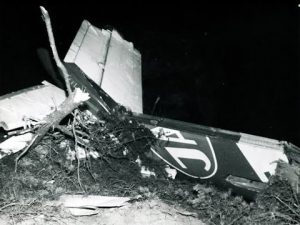 1974, stated that there had been an explosion in the front baggage compartment of the plane. The Czechoslovak secret service, which was leading the investigation, presented parts of an alarm clock ten days after the crash which they claimed came from a bomb. The report concluded that a bomb brought down Flight 367. That morning, an anonymous man called the newspaper Kvällsposten published in Malmö, Sweden, claiming, in broken Swedish, that he was a Croat and member of a nationalist group that placed the bomb on the plane. Shortly after the phone call, the Yugoslav government blamed the Ustaše. According to the official report the explosion tore the McDonnell Douglas DC-9-32 to pieces in mid-air. Vulovic was the only survivor.
1974, stated that there had been an explosion in the front baggage compartment of the plane. The Czechoslovak secret service, which was leading the investigation, presented parts of an alarm clock ten days after the crash which they claimed came from a bomb. The report concluded that a bomb brought down Flight 367. That morning, an anonymous man called the newspaper Kvällsposten published in Malmö, Sweden, claiming, in broken Swedish, that he was a Croat and member of a nationalist group that placed the bomb on the plane. Shortly after the phone call, the Yugoslav government blamed the Ustaše. According to the official report the explosion tore the McDonnell Douglas DC-9-32 to pieces in mid-air. Vulovic was the only survivor.
Vulovic suffered a fractured skull, three broken vertebrae, one of which was crushed completely, and that left her temporarily paralyzed from the waist down, and two broken legs. She was in a coma for 27 days. In an interview, she commented that according to the man who found her, “…I was in the middle part of the plane. I was found with my head down and my colleague on top of me. One part of my body with my leg was in the plane and my head was out of the plane. A catering trolley was pinned against my spine and kept me in the 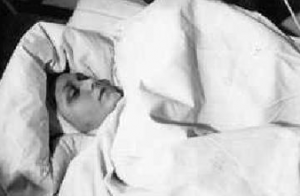 plane. The man who found her said she was lucky. He was in the German Army as a medic during World War II. He knew how to treat trauma. The medic is identified as Bruno Henke. Vulovic continued working for JAT Airways at a desk job following a full recovery from her injuries. She regained the use of her legs and continued to fly sporadically. She claimed she had no fear of flying, which she attributed to her loss of memory of the crash, and she even enjoyed watching movies with plane crashes. She was considered a national heroine throughout the former Yugoslavia and was awarded the Guinness Record title by Paul McCartney at a ceremony in 1985. As to becoming the world record freefall holder, Vesna comments, “I am like a cat, I have had nine lives.”
plane. The man who found her said she was lucky. He was in the German Army as a medic during World War II. He knew how to treat trauma. The medic is identified as Bruno Henke. Vulovic continued working for JAT Airways at a desk job following a full recovery from her injuries. She regained the use of her legs and continued to fly sporadically. She claimed she had no fear of flying, which she attributed to her loss of memory of the crash, and she even enjoyed watching movies with plane crashes. She was considered a national heroine throughout the former Yugoslavia and was awarded the Guinness Record title by Paul McCartney at a ceremony in 1985. As to becoming the world record freefall holder, Vesna comments, “I am like a cat, I have had nine lives.”

